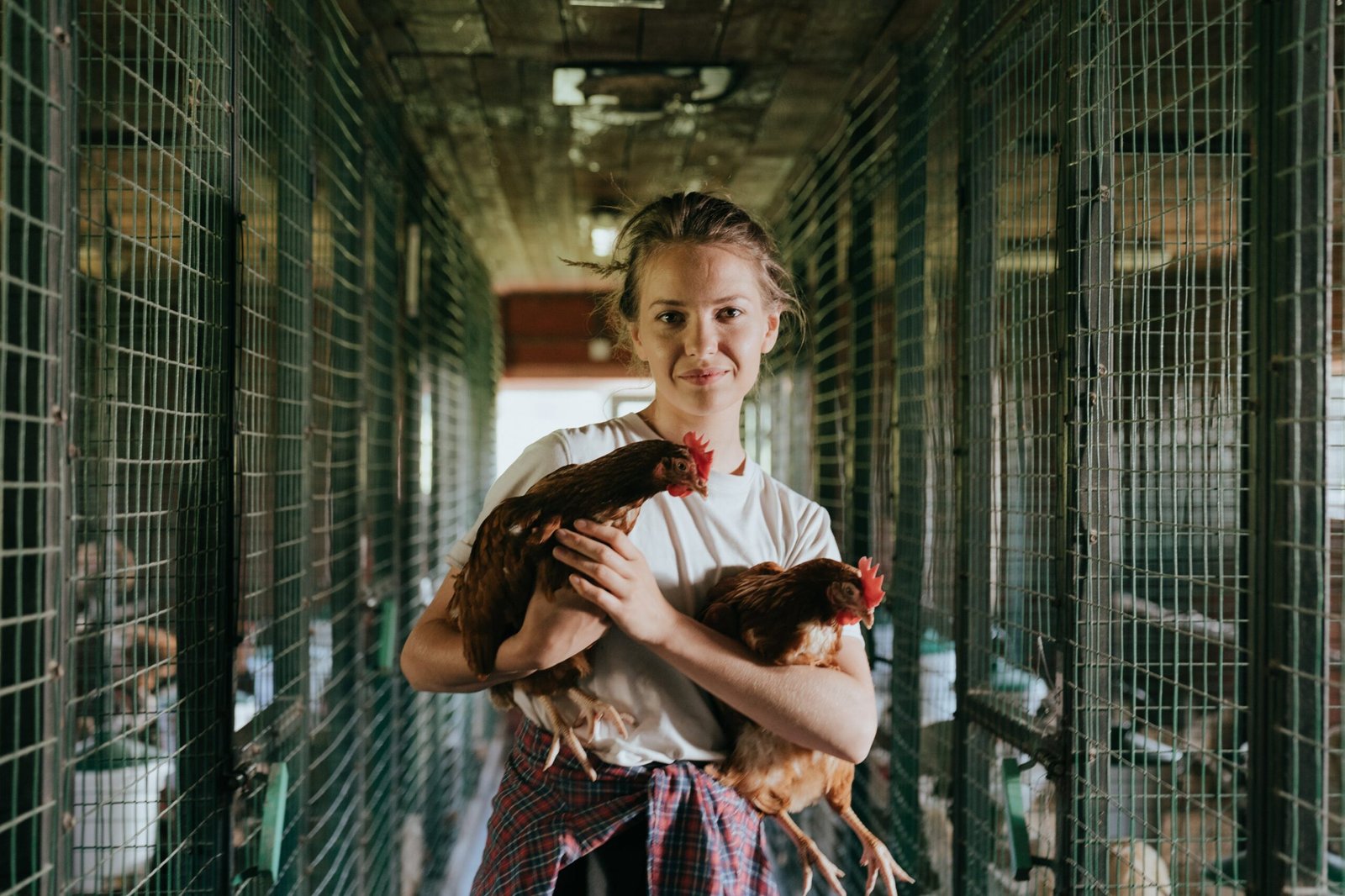
Imagine a future where chickens roam freely in a fully automated, tech-driven coop, living a life of comfort and convenience. No longer confined to traditional farm settings, these high-tech coops offer state-of-the-art features designed to cater to the needs of these feathered friends. From automated feeding and watering systems to temperature and lighting controls, these innovative coops aim to revolutionize the way we raise chickens. But is this bold vision of a futuristic chicken coop truly feasible, or just a flight of fancy? Let’s investigate the possibilities and implications of raising chickens in a fully automated, tech-driven coop.

Benefits of a Fully Automated Coop
Increased Efficiency
A fully automated coop offers increased efficiency in many ways. With automated systems for feeding, watering, and temperature control, you can ensure that your chickens receive the necessary resources at the right time, without the need for constant monitoring. This allows you to focus your time and energy on other aspects of chicken farming, such as monitoring health and behavior or implementing biosecurity measures.
Reduced Labor
Automated systems significantly reduce the labor required to manage a chicken coop. Instead of manually feeding the chickens multiple times a day, an automatic feeding system can dispense the required amount of feed at regular intervals. Likewise, automated watering systems ensure a constant supply of fresh water without the need for daily refilling. By eliminating these repetitive and time-consuming tasks, you can save valuable time and effort.
Improved Biosecurity
Biosecurity is a crucial aspect of poultry farming to prevent the spread of diseases. A fully automated coop can enhance biosecurity measures by reducing the need for human interaction with the chickens. With automated feeding and watering systems, there is less risk of introducing harmful pathogens or contaminants into the coop. Additionally, strict sanitation practices and regular health screenings can be implemented more effectively in an automated coop, further reducing the risk of disease outbreaks.
Automation Systems in a Tech-driven Coop
Automatic Feeding
Automatic feeding systems in a tech-driven coop ensure that chickens receive their required amount of feed at regular intervals. These systems use timers or sensors to dispense the appropriate amount of feed, preventing overfeeding or underfeeding. With automated feeding, you can ensure a balanced diet for your chickens, promote healthy growth, and minimize waste.
Automated Watering
Proper hydration is essential for the health and well-being of chickens. Automated watering systems provide a constant supply of fresh water to the chickens without the need for manual refilling. These systems typically use nipple or cup drinkers, which are more hygienic and prevent water contamination. By automating the watering process, you can ensure that your chickens always have access to clean water, reducing the risk of dehydration and related health issues.
Temperature Control
Maintaining the right temperature is crucial for the overall health and productivity of chickens. In a tech-driven coop, temperature control systems can automatically adjust the heat or cooling based on preset parameters. This ensures that the coop remains within the optimal temperature range, regardless of external weather conditions. By providing a comfortable environment, you can prevent stress and health problems, ultimately improving the overall well-being of your chickens.
Lighting Control
Proper lighting is essential for the growth, behavior, and egg production of chickens. In a fully automated coop, lighting control systems can regulate the intensity and duration of light exposure. This allows you to mimic natural daylight patterns, promoting regular egg-laying and reducing the risk of behavior abnormalities. With automated lighting, you can also ensure energy-efficient operation and minimize electricity usage.
Ventilation System
Good air quality and proper ventilation are vital for maintaining a healthy coop environment. Automated ventilation systems can regulate the airflow, removing excess moisture, ammonia, and odors. These systems can incorporate sensors to monitor the air quality and adjust the ventilation accordingly. By automating the ventilation process, you can prevent the buildup of harmful gases, minimize respiratory issues, and create a comfortable living space for your chickens.

Ongoing Maintenance and Monitoring
Regular Cleaning
Regular cleaning is essential for maintaining a healthy, hygienic coop. In an automated coop, you may still need to perform some manual cleaning tasks, such as removing waste or debris. However, automation systems can simplify the cleaning process by reducing the accumulation of waste through efficient feeding and watering methods. Additionally, automated systems can provide alerts or reminders for specific cleaning tasks, ensuring that you stay on top of maintenance.
Checking and Replacing Equipment
Like any technology, automation systems in a coop may require periodic checks and occasional equipment replacements. It is important to regularly inspect the automated systems to ensure they are functioning correctly. This includes checking sensors, timers, and mechanical components. By promptly addressing any issues and replacing faulty equipment, you can maintain the smooth operation of your fully automated coop.
Monitoring Health and Behavior
Even with automation systems in place, monitoring the health and behavior of your chickens remains crucial. Automated systems can assist in monitoring temperature, feed consumption, and water usage, providing valuable data for assessing the overall health of the flock. However, it is essential to regularly observe the chickens for signs of illness or abnormal behavior. This allows you to promptly intervene if any health issues arise, ensuring the well-being of your chickens.
Ensuring Proper Nutrition
Automated Feeding Systems
Automated feeding systems contribute to ensuring proper nutrition for your chickens. These systems can be programmed to dispense specific types and quantities of feed, promoting a balanced diet. By automating the feeding process, you can ensure that each chicken receives its required portion, preventing overfeeding or underfeeding. Some advanced automated feeding systems can even consider individual chickens’ specific dietary needs, optimizing nutrition for healthier and more productive flocks.
Balanced Diet Formulation
In addition to automated feeding, proper diet formulation is crucial for the well-being of your chickens. Consider consulting with a poultry nutritionist to develop a balanced diet that meets the specific nutritional requirements of your flock. By formulating a well-balanced diet, you can optimize egg production, promote healthy growth, and enhance the overall health of your chickens.
Supplementing with Vitamins and Minerals
Supplementing your chickens’ diet with vitamins and minerals can further enhance their health and productivity. Automation systems can simplify the process by automatically dispensing the necessary supplements in predetermined quantities. Consult with a poultry nutritionist to determine the appropriate supplementation regimen for your chickens, considering their specific needs and the local feed availability.

Preventing Disease and Maintaining Biosecurity
Strict Sanitation Practices
Maintaining strict sanitation practices is essential for preventing the spread of diseases in a fully automated coop. Regularly cleaning and disinfecting the coop, equipment, and water sources can help eliminate potential pathogens. Automation systems can aid in this process by minimizing direct human contact with the chickens, reducing the risk of contaminating the environment. Implementing automated cleaning systems, such as automated manure removal or disinfection systems, further improves biosecurity in the coop.
Isolation and Quarantine Areas
To prevent the spread of diseases, it is crucial to have isolation and quarantine areas within your coop. These areas allow you to separate sick or potentially infected chickens from the rest of the flock. Automation systems can help manage these areas by providing controlled access, automated feed and water systems, and separate ventilation systems. By effectively isolating and quarantining affected chickens, you can protect the health of the entire flock.
Regular Health Screenings
Implementing regular health screenings is essential for early detection and prevention of diseases in your flock. Automated monitoring systems can assist in monitoring vital parameters such as body temperature, feed consumption, and behavior patterns. Additionally, automated health screening technologies, such as thermal imaging or automated blood sampling, can provide valuable data for assessing the health status of individual chickens. By proactively monitoring and addressing health issues, you can maintain a healthy and disease-free flock.
Addressing Animal Welfare Concerns
Providing Adequate Space and Roaming Area
Animal welfare is of utmost importance in chicken farming. To ensure the well-being of your chickens, provide them with adequate space to move and roam freely. Automation systems can assist in this by monitoring and controlling the number of chickens allowed in specific areas. By avoiding overpopulation and providing sufficient space, you can reduce stress and promote natural behaviors, ultimately enhancing the welfare of your chickens.
Ensuring Comfortable Bedding and Nesting Materials
Comfortable bedding and nesting materials are essential for the health and comfort of your chickens. Automation systems can be utilized to maintain clean and dry bedding by automatically replenishing or replacing it when needed. Additionally, automated systems can ensure the availability of suitable nesting materials, promoting natural nesting behaviors and egg-laying. By providing a comfortable environment, you create a happier and healthier living space for your chickens.
Minimizing Stress and Anxiety
Stress and anxiety can have detrimental effects on the health and productivity of chickens. Automation systems can help minimize stress by providing a consistent and predictable environment. By regulating factors such as lighting, temperature, and ventilation, you can create a stress-free environment for your chickens. Additionally, automated systems can minimize noise disturbances, further reducing stress levels. Minimizing stress and anxiety contributes to improved overall welfare and better chicken performance.
Monitoring and Controlling Environmental Factors
Temperature and Humidity Levels
Maintaining optimal temperature and humidity levels is crucial for the well-being of your chickens. Automation systems can continuously monitor and control these factors, ensuring a comfortable environment. By utilizing sensors and actuators, the temperature and humidity levels can be adjusted automatically based on set parameters. This helps prevent heat stress or cold-related health issues and provides optimal conditions for your chickens.
Lighting Patterns and Intensity
Lighting plays a significant role in the behavior and productivity of chickens. Automation systems can regulate lighting patterns and intensity, mimicking natural daylight cycles. This helps maintain regular egg-laying patterns and promotes healthier behaviors. By automating the lighting system, you can optimize egg production, save energy, and create a more sustainable operation.
Air Quality and Ventilation
Good air quality and proper ventilation are vital for a healthy coop environment. Automation systems can monitor air quality and adjust ventilation accordingly. This helps remove excess moisture, ammonia, and odors from the coop, ensuring fresh and clean air for your chickens. By maintaining optimal air quality and ventilation, you can prevent respiratory issues and promote overall health.
Distinguishing Between Essential Human Interaction and Automation
Socialization and Enrichment Activities
While automation can streamline many aspects of chicken farming, human interaction remains important for the well-being of the chickens. Providing socialization and enrichment activities, such as gentle handling, supervised free-ranging, or the introduction of toys, contributes to the mental and physical stimulation of the chickens. It is crucial to strike a balance between automation and human interaction to ensure the social well-being of your flock.
Health Checks and Veterinary Care
Regular health checks and veterinary care are essential for maintaining the health of your chickens. While automated monitoring systems can provide valuable data, professional veterinary care and physical examinations are crucial for detecting and treating health issues. Ensure that you consult with a poultry veterinarian regularly to conduct comprehensive health checks, perform necessary vaccinations, and address any concerns that may arise.
Breeding and Genetic Selection
Breeding and genetic selection play a significant role in the overall productivity and quality of your flock. Although automation systems can assist in monitoring and gathering data related to genetics, breeders, and hatcheries, human intervention and selection are essential for achieving desired genetic outcomes. Collaborate with experienced breeders and geneticists to make informed decisions and optimize the genetic potential of your flock.
Cost Considerations of Automated Coops
Initial Investment
Implementing a fully automated coop involves an initial investment in automation systems and equipment. The cost varies depending on the size of the coop, the complexity of the automation systems, and the quality of the equipment. Consider the long-term benefits and savings, such as reduced labor costs and improved efficiency, when evaluating the initial investment required.
Maintenance and Upkeep Costs
Like any technology, automated systems require regular maintenance and occasional repairs. It is important to factor in the costs of maintaining and servicing the automation equipment. This includes routine inspections, cleaning, and potential replacement of components. Proper maintenance ensures that the systems function optimally and have a longer lifespan, ultimately reducing overall costs.
Return on Investment
While the initial investment and ongoing maintenance costs must be considered, a fully automated coop has the potential to provide a significant return on investment. By reducing labor requirements, increasing efficiency, and improving biosecurity, automation systems can contribute to higher productivity and profitability. Calculate the potential cost savings, increased egg production, and improved flock health to assess the return on investment of implementing automation in your coop.
Conclusion: The Future of Chicken Farming
The future of chicken farming lies in the integration of automation systems that prioritize animal welfare, environmental sustainability, and technological innovation. A fully automated, tech-driven coop offers numerous benefits, including increased efficiency, reduced labor, and improved biosecurity. By automating feeding, watering, temperature control, lighting, and ventilation, you can optimize the environment for your chickens while minimizing manual labor and reducing risks associated with disease transmission.
Ongoing maintenance and monitoring remain essential to ensure the smooth operation of automation systems. Regular cleaning, equipment checks, and health monitoring are crucial for maintaining a healthy and productive flock. Additionally, ensuring proper nutrition through automated feeding systems and balanced diet formulation enhances the overall health of your chickens.
Alongside automation, biosecurity measures should be strictly adhered to, including sanitation practices, isolation areas, and regular health screenings. These measures help prevent the spread of diseases and maintain the biosecurity of your coop.
Addressing animal welfare concerns is paramount in a fully automated coop. Providing adequate space, comfortable bedding, and minimizing stress and anxiety contribute to the well-being of your chickens. Balancing automation with essential human interaction, such as socialization, veterinary care, and genetic selection, is crucial for ensuring optimal animal welfare.
Monitoring and controlling environmental factors, including temperature, humidity, lighting, and air quality, are essential for maintaining a healthy coop environment. Automation systems can aid in regulating these factors, providing optimal conditions for your chickens.
While there are cost considerations associated with implementing automation, the potential benefits, such as increased productivity and improved efficiency, can provide a significant return on investment. Balancing the initial investment with long-term cost savings and increased profitability is key.
In conclusion, a fully automated, tech-driven coop has the potential to revolutionize chicken farming. By embracing automation while prioritizing animal welfare and sustainability, you can create an efficient, productive, and environmentally friendly operation. As technology continues to evolve and innovate, the future of chicken farming promises even more advancements to enhance the well-being and productivity of our feathered friends.






